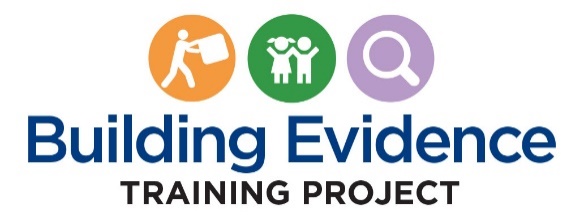Building Evidence Training (BET) Project Usability Testing
Fast Track Generic Clearance for Collection of Qualitative Feedback on Agency Service Delivery
Unit_3_Pre-Post_Test OMB Final
Building Evidence Training (BET) Project Usability Testing
OMB: 0970-0401
Expiration Date: 05/31/2021
PAPERWORK REDUCTION ACT OF 1995 (Pub. L. 104-13) STATEMENT OF PUBLIC BURDEN: The purpose of this information collection is to gain feedback on the course content and delivery. Public reporting burden for this collection of information is estimated to average .12 hours per response, including the time for reviewing instructions, gathering and maintaining the data needed, and reviewing the collection of information. This is a voluntary collection of information. An agency may not conduct or sponsor, and a person is not required to respond to, a collection of information subject to the requirements of the Paperwork Reduction Act of 1995, unless it displays a currently valid OMB control number. If you have any comments on this collection of information, please contact the Building Evidence Training Project at: [email protected]
Designing and Implementing Evidence-Supported Interventions in Child Welfare

Unit 3 PRE/POST TEST:
Identify the Problem and Understand the Target Population
Questions
Which statement best describes the relationship between evidence-supported interventions (ESIs) and evidence-based practice (EBP)?
A third party determines whether an ESI has sufficient evidence to be used in EBP.
A social worker using EBP should always select the ESI that is supported by the most rigorous evidence.
A social worker using EBP integrates clinical expertise with knowledge of ESIs and family preferences in the selection of interventions. (Correct answer)
All of the above.
True or False: The implementation framework used for this course includes performing a root cause analysis before selecting and implementing an intervention.
A theory of change:
Explains the psychological process for creating enduring changes in a client’s life.
Is developed after an intervention is selected to communicate to stakeholders how it will address the problem.
Is part of the team charter that should be developed at the implementation team’s first meeting.
Is a hypothesis that describes the root cause of the problem, the desired outcome(s), and how to reach those outcomes. (Correct answer)
Which of the following is an important reason for including child welfare frontline workers and supervisors on a team assigned to study the population at risk for a problem and develop a theory of change?
Day-to-day interactions with children and families receiving services gives frontline workers and supervisors important insights into understanding the population at risk. (Correct answer)
Frontline workers need to learn about implementation science in order to properly complete child safety assessments.
If frontline workers are included on teams, data gathering and analysis will not be necessary.
Frontline workers’ schedules are more flexible than those of high level administrators.
Which of the following is not an element of a theory of change?
Desired ultimate outcome
Steps to bring about the outcome
Hypothesized causal pathway
Specification of the communications protocol (Correct answer)
Measurable intermediate outcomes
Which of the following are not criteria useful for assessing a theory of change?
Which of the following is consistent with the sequence of steps recommended in the Development, Implementation and Assessment Approach?
Select a theory of change Understand the population at risk Identify the problem
Identify the problem Understand the population at risk Develop a theory of change (Correct answer)
Conduct a root cause analysis Understand the population at risk Identify the problem Develop a theory of change
None of the above
Select the answer that best defines “evidence-supported intervention.”
The integration of the best available research evidence with clinical and child welfare practice expertise and child and family characteristics, culture, and preferences.
The complete process of identifying, describing, and analyzing strengths and problems and then testing, implementing, learning from, and revising strategies to improve performance.
A research study that employs treatment and comparison groups to determine the effectiveness of interventions.
A well-defined program, practice, policy, or other strategy that has shown the potential, through rigorous evaluation, to improve outcomes for children and families. (Correct answer)
Select the answer that best describes an important function of a communications protocol:
It describes how to implement an intervention with fidelity--the way it was designed.
It provides the action-planning model to systematically develop, manage, and evaluate interventions.
It specifies the frequency and methods of communication among associated teams to ensure a coordinated effort. (Correct answer)
It identifies the mission, goals, objectives, and deliverables of the implementation team.
Select the accurate statement about teaming.
A team that includes frontline staff and supervisors, with an understanding of the population at risk for a problem and the root causes, can identify potential target populations for an intervention and develop one or more theories of change. (Correct answer)
The value of teaming is unique to the process of implementing child welfare interventions.
The teaming structure developed for one implementation team will work for any intervention or agency.
Teaming is only important during the exploration stage.
All of the above.
Unit 3 Pre/Post Test Questions
| File Type | application/vnd.openxmlformats-officedocument.wordprocessingml.document |
| File Modified | 0000-00-00 |
| File Created | 2021-01-14 |
© 2026 OMB.report | Privacy Policy